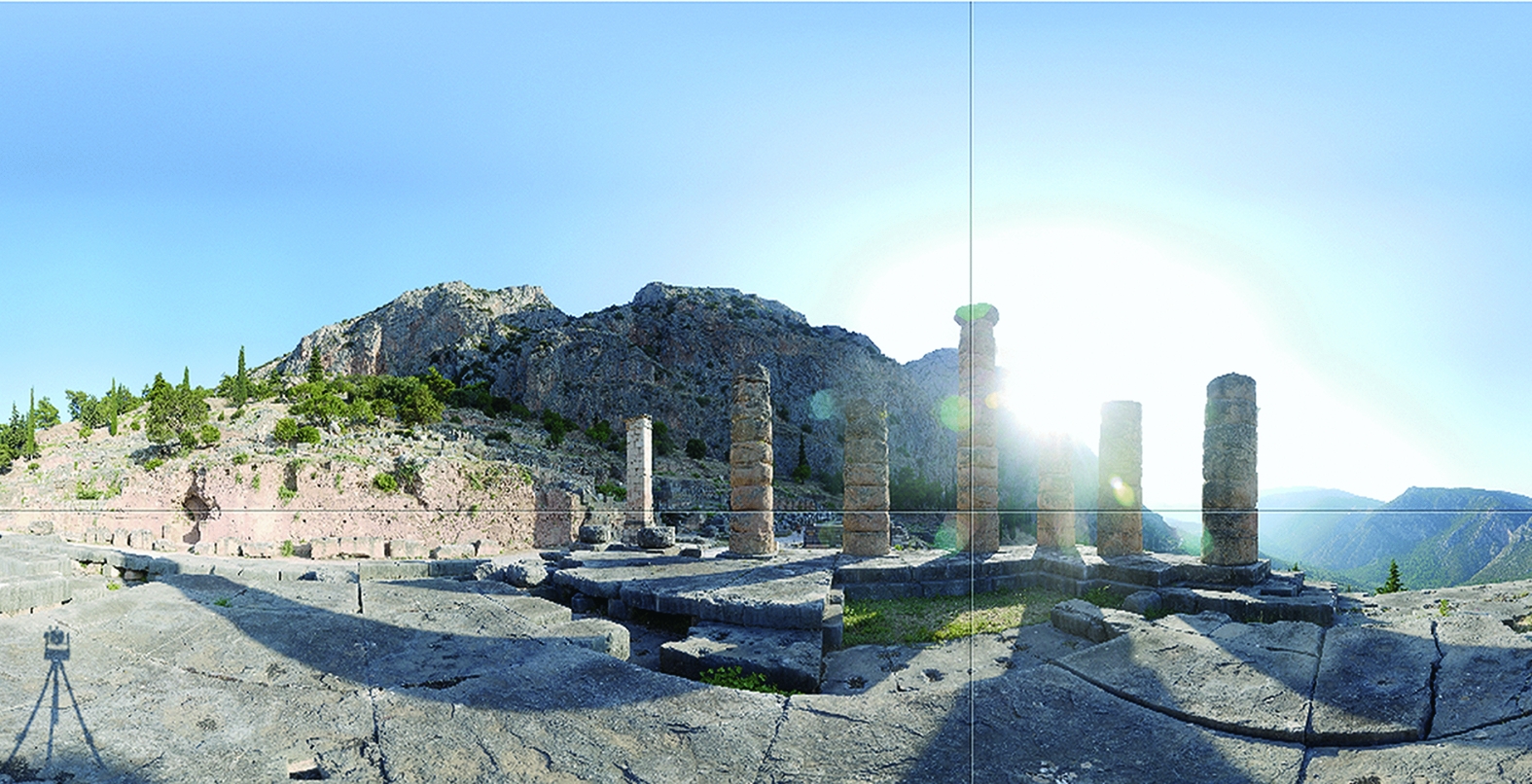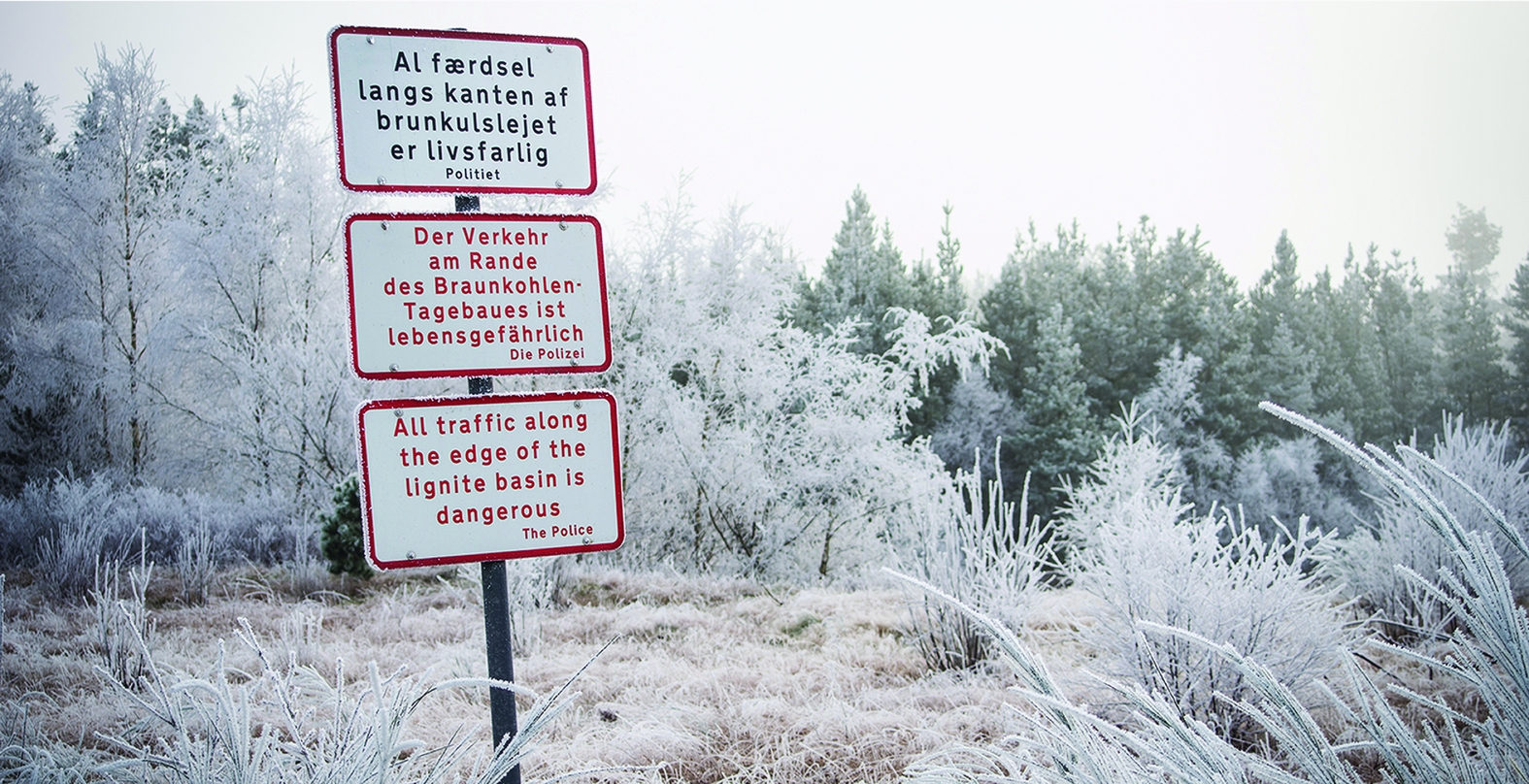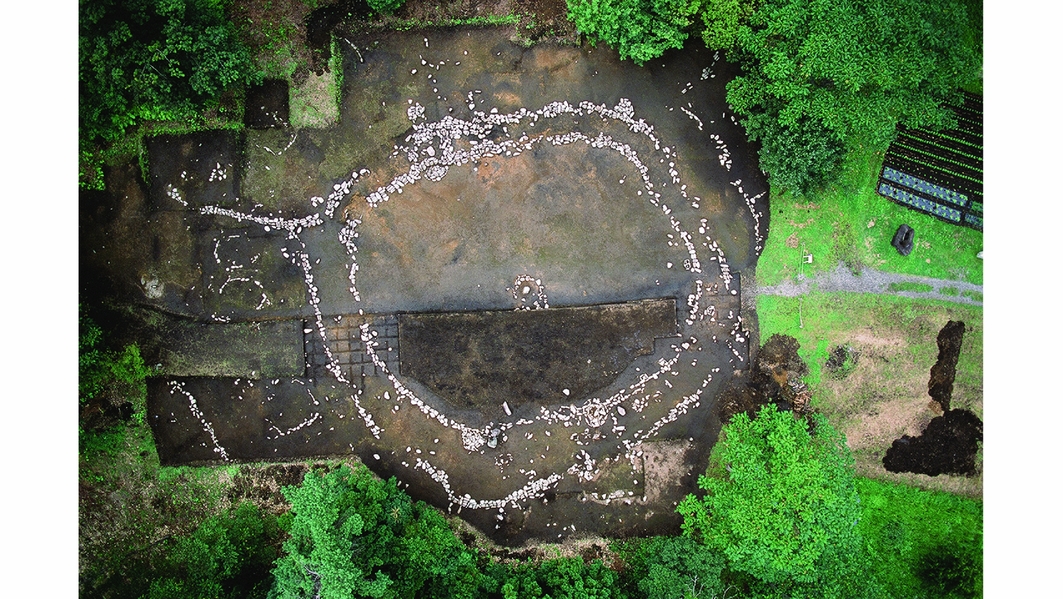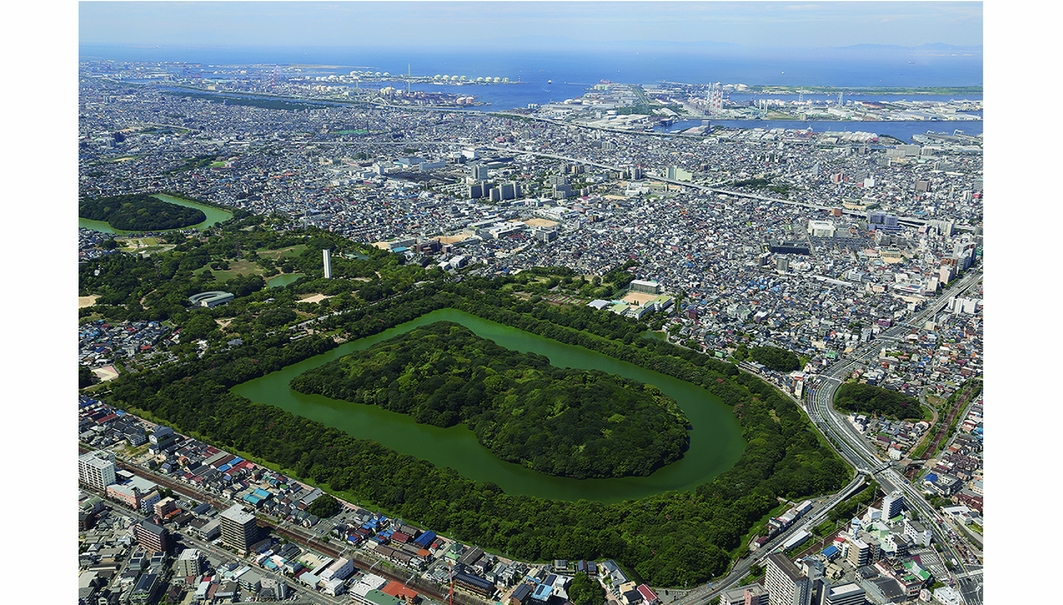
CAVEcam image of the Temple of Apollo in Delphi Greece, created by stitching together 360 × 180o panoramic views. Photographs taken in 2015 by Thomas Levy and collaborators as part of the Digital Enterprise for Learning Practice of Heritage Initiative FOR Delphi (‘Delphi4Delphi’) research project (featured in this issue's Project Gallery—Liritzis et al.).

Multilingual warning signs at the Søby mining area today in central Denmark (featured in this issue's Project Gallery—Riede et al.).
Conferences are the lifeblood of academic dialogue, and mark well-worn entries in the academic calendar. The main annual archaeological conferences each have their regular slot: SAA in April; its European equivalent, EAA, in September; AIA in January. Then there are UISPP and WAC, which occur every four years. It would be a rare archaeologist who has the breadth of interest (or the time) to attend all of these, but it is nonetheless a pity when they overlap. In 2014, EAA in Istanbul followed hard on the heels of UISPP in Burgos, but an energetic traveller would have been able to speak at both. Alas that was not possible this year, when EAA in Vilnius opened while WAC-8 in Japan was in mid-flow. Antiquity was present at both, and can report that despite the overlap, both were highly successful. While Reviews Editor Rob Witcher enjoyed the delights of Vilnius, I had the pleasure of attending WAC.
The Eighth World Archaeological Congress was held at Doshisha University in Kyoto, the former capital city of Japan. WAC-8 brought together over 1600 participants from 83 countries, and remains probably the largest archaeological conference in terms of breadth and diversity. It is also distinguished by its willingness to address difficult themes such as archaeology in the Palestinian territories (covered in two special forums) and the decolonisation of African archaeology (subject of this year's Peter Ucko Memorial Lecture). Mention of Peter Ucko reminds us also that 2016 marks the thirtieth anniversary of the foundation of WAC. The WAC message is that archaeology is unavoidably political, whether we want it to be or not, and that it is better for us to discuss those issues together rather than wish that they did not exist. Archaeology by itself, of course, has some, and only some, of the answers.
WAC-8 was a great opportunity to meet Antiquity authors, reviewers and readers. It was also a wonderful chance to see some Japanese archaeology at first hand. The quality and quantity of the fieldwork, and the interest of the results, are truly remarkable. What is also striking is how little of this is familiar to Western audiences, and what we are missing as a result. The language barrier, as always, is part of the problem, but we hope we can encourage our Japanese colleagues to make more of their results available in international journals.
The Japanese Neolithic?
The underpinnings of Japanese rescue archaeology lie in the Archaeological Heritage Management service established in the 1960s. With local government funding, some of it covered by payments from developers, excavations have been carried out on a scale that would be the envy of archaeologists working in many other countries—even during the recent recession, as many as 9000 rescue excavations were carried out annually, in a country with over 440000 registered archaeological sitesFootnote 1 , Footnote 2 . One of the main beneficiaries of all this activity has been the lengthy prehistoric phase known as the Jōmon. It refuses to fit into the neat period categories beloved of European prehistorians, as Jōmon communities eschewed crop cultivation yet lived in settled communities with an elaborate material culture more reminiscent of the European Neolithic than the Mesolithic.
Jōmon archaeology has featured several times in Antiquity, most recently in our October issue (‘Hunting dogs as environmental adaptations in Jōmon Japan’ by Angela Perri, Antiquity 90: 1166–80). There are Jōmon sites throughout the Japanese archipelago, with a particularly interesting group at the northern end of Honshū. These include large settlement sites, shell middens and stone circles. One of the latter, at Oyu in Akita prefecture, featured in an Antiquity editorial back in 2010, when Martin Carver drew comparisons with Stonehenge. Oyu, as with Stonehenge, has a road problem: route 66, which passes between the Manza and Nonakado circles, fracturing the integrity of the site. The main culprit at Stonehenge, the A344, has now been closed and a new visitor centre created. Stonehenge has been reunited with its Avenue. The A303 expressway still rumbles past the southern edge of the site, although it is the subject of renewed tunnel proposals. Let us hope a proper solution is found for Stonehenge, but cost will probably be the stumbling block again, just as it was last time round.
Oyu is one of several stone circles of the late Jōmon period that are included in a bid for UNESCO World Heritage Status. To give it its full title, ‘Jōmon Archaeological Sites in Hokkaidō and Northern Tōhoku’ incorporates no fewer than 16 sites on northern Honshū and southern Hokkaidō. Four of them are stone circles. These are not like European stone circles: the stones are not set upright in the ground but laid out flat on the surface in a ring. And yet they are complex settings for all that, with individual stones arranged according to colour or grouped horizontally and vertically to create repeated patterns. It is also interesting that while the circles are invariably on higher ground, they are formed exclusively of river pebbles, sometimes from rivers that are nearby but far below. And whereas the individual stones do not reach the megalithic proportions of Stonehenge or Stanton Drew, the landscaping involved was sometimes prodigious. At Komakino, an entire hillside was cut into and terraced out to form a suitable surface for the stone circle, offering breathtaking views over Mutsu Bay.

Overhead view of the stone circle at Komakino. Image courtesy of the Aomori City Forestry Museum.
Other sites in the Jōmon WHS bid are settlements, some of them with hundreds of overlapping house plans. This is a relatively remote region of Japan, a far cry from the densely peopled landscapes of Tokyo and Osaka, and Japanese archaeologists have gone to considerable lengths to make them attractive, accessible and comprehensible to visitors. There are site museums, in most cases a short distance from the site itself and hence discreetly out of view. At Goshono, a curving timber bridge takes the visitor across a steep-sided valley to the museum and the site beyond: the latter an extensive multi-phase settlement presented today as parkland with a selection of the original houses reconstructed. The modern world scarcely intrudes. The largest of all the sites, and the biggest site museum, is at Sannai-Maruyama on the outskirts of Aomori cityFootnote 3 . Here, a different approach has been taken, with protective domes covering some of the excavated house floors, and the buildings themselves reconstructed alongside. It is still hard to grasp the 800 house floors estimated to lie beneath the turf, although the site does cover a large area.
Sannai-Maruyama without the reconstructions would be a hard sell for the general public, even with its excellent modern museum displaying serried ranks of Jōmon pots and dogū figurines. But it raises difficult issues. How do we know what the superstructures originally looked like? This is highlighted by the different interpretations we are offered at Sannai-Maruyama and at Goshono. Is it better to build the reconstruction on the same spot, or on an adjacent plot, so that the visitor can see the excavated house floor next to the replica building? These are not easy questions to resolve, yet modern technology may hold some of the answers. Sannai-Maruyama now has virtual reality reconstructions for tablet computers, triggered by GPS at appropriate moments as you walk around the site, so that visitors can view the Jōmon world without the damage to the archaeology that reconstructing timber buildings inevitably involves.
Taken together, the settlements and stone circles of northern Honshū offer a fascinating insight into the Jōmon world. They show how much can be achieved when funding and local commitment are combined effectively. Inscribing prehistoric sites on the WHS list is always a problem. They do not have the scale and architectural sophistication of Petra or Palenque, but they are nonetheless valuable for all that, and if they are challenging to explain to a non-specialist public, that is a challenge we should be prepared to grasp.
Three Age bicentenary
Whether the Jōmon is strictly ‘Neolithic’ or not is hardly of great significance. Much more important is the reminder it gives us of what societies reliant on hunting and foraging were able to achieve. They are far removed from the images of hunger and destitution that some nineteenth-century schemes of social evolution would have us believe drove people to farming. Yet nineteenth-century frameworks of Stone, Bronze and Iron still loom large in European prehistory, and make it appropriate to mention an important bicentenary that falls at the very end of this year. For it was at New Year 1817 that Rasmus Nyerup resigned as Secretary of the Danish Oldsagskommissionen (the Royal Commission for the Preservation of Antiquities), and that Christian Jürgensen Thomsen was appointed in his place. Thomsen's key responsibility was the collection of antiquities stored at that time in the loft of the Trinitatis Church in Copenhagen. To bring order to this collection, he purchased new display cabinets and used them to arrange the objects according to their materials: stone, bronze and iron. Within little more than three years, the new displays were ready for inspection, and the Three Age system was bornFootnote 4 .
There are many parts of the world where this nineteenth-century scheme does not apply, nor Lord Avebury's later addition of an Old Stone Age to the New, nor Hodder Westropp's recognition of a separate Mesolithic shortly afterwards. There are ground stone tools in pre-contact Australia, but to label them Neolithic would be confusing rather than illuminating. Even within Europe, these periods sit awkwardly, attached as they are to societies of very different kinds living at different times and in different places, with variable chronologies. The Neolithic in the Balkans, for example, had already ended by the time the Neolithic in Britain began. Yet old habits die hard, and we still find them useful shorthand. Indeed, some would go further and advocate a British Chalcolithic, inserted between the Neolithic and the Bronze AgeFootnote 5 . The Chalcolithic has a long history in Continental European research, but whether we gain anything by adding new categories of this kind is not altogether clear.
The wider resonance of British archaeology was one of the themes covered at WAC-8, in a session sponsored by the Sainsbury Institute for the Study of Japanese Arts and Cultures. A series of speakers explored how major recent projects might be presented and evaluated in their international context—whether that be through their contribution to the understanding of human social development at the global scale, or through the new techniques and approaches that they espouse. The examples in this case were drawn from British prehistory, but the same issues apply everywhere. Coming together in a session such as this reminds us of what we can learn from closer contact with colleagues from other regions—regions whose archaeology we may not be immediately familiar with—and the rich harvest of new ideas and new approaches that are available. But at the same time, as the Three Age system reminds us, we should avoid the pitfalls of overly grand narratives.
Mounds for the ancestors
Burial mounds, that omnipresent feature of most regional archaeologies, instantly evoke ideas of ancestors. Why bury people in such conspicuous style if they were not to be remembered? But ancestors of a different kind came to mind when half an hour's train journey from Kyoto brought me to the enormous mounded tombs known as kofun on the outskirts of Osaka. Here, following in Martin Carver's footsteps, I spent a day as a guest of the Mozu-Furuichi World Heritage bid, visiting the vast keyhole tombs on the coastal plain to the south of the city. It is hard to take in their size; indeed, the best way to do that is from the air, and we were privileged to have a bird's-eye view courtesy of a special helicopter ride. Seen from this vantage point, the densely built-up residential patchwork stretches into the distance, interrupted every now and then by a wooded hill, surrounded by a moat (sometimes more than one), and most of them taking a distinctive keyhole shape: these are the zempō-kōen-fun of the Mozu and Furuichi cemeteries.

The triple-moated Daisen kofun, the largest of the keyhole-shaped zempō-kōen-fun tumuli, erroneously attributed to the Emperor Nintoku. View from a helicopter over Sakai City, Osaka Prefecture.
There are 59 tombs in the Mozu-Furuichi WHS bid. The largest of them rival in size the pyramids at Giza, or Qin Shihuangdi's tomb at Xi'an in China, and on that reckoning alone, they must be outstanding candidates for WHS inscription (an opinion shared by the previous editor, Martin CarverFootnote 6 ). The Daisen kofun measures no less than 486m in length, or 840m if the triple moat is included. What is also striking is the standardisation in shape, repeated across several centuries and through most of Honshū, Shikoku and Kyūshū. There was clearly a set of well-defined norms, rigidly enforced by the elites engaged in the rapid journey to statehood in the third to fifth centuries AD. Equally impressive is the sudden change in the sixth century, when the rulers converted to Buddhism and tomb-building was thenceforth forbidden. The centralised control of the dominant ideologies is remarkable.
Visiting the Mozu-Furuichi kofun today brings a mixture of excitement and frustration. The tree-covered mounds rear up among the houses, but most of them are out of bounds, controlled by the Imperial Household Agency. The emperors who lie there are not to be disturbed. The largest are attributed to named rulers, although the archaeology does not always agree. The Daisen kofun, for example, dated to the fifth century by archaeologists, is attributed by the Imperial Household Agency to the fourth-century emperor Nintoku (and named Nintoku-tenno-ryo). Conservation is also a problem, with inevitable damage from tree roots and erosion from the water of the encircling moats—large enough for waves to form on windy days. Recent co-operation between the Imperial Household Agency and the regional archaeological service, however, is showing the way forward in that respect. If the tombs themselves are out of bounds, visitors can still gain insight from the excellent museums. These also display finds from the smaller, non-imperial tombs: suits of iron armour (the iron itself from Korea), and examples of the many haniwa ceramic figures that once fringed the mounds. The Chikatsu-Asuka museum is especially impressive, its centrepiece a large reconstruction of the Daisen mausoleum assigned to the Emperor Nintoku that is breathtaking in size and detail (and was hugely expensive to create).
Maybe it is sufficient to rely on a network of museums and noticeboards to explain the zempō-kōen-fun of the Mozu-Furuichi group. Perhaps, in any event, the ordinary visitor would not gain much more from being able to scramble up the mounds themselves. The radical solution would be to clear the trees and reconstruct their appearance. That has been done elsewhere, at Goshikizuka kofun near Kobe, for example. The result is striking, with minimal disturbance to the archaeology (only the surface has been restored), although it is no minor feat: Goshikizuka is 194m long and 18m high. I would not expect that many archaeologists would want to see that done everywhere, even if the resources required for such massive structures as the Daisen and Konda Gobyoyama tombs were available. Public access may still be an issue when the WHS bid comes to UNESCO, but let us hope that the monuments speak for themselves, and that the continuing reverence for the imperial tombs is treated with sensitivity. Nor should the urban setting be a problem: the way these massive tombs overshadow the modern housing nestled around them is indeed one of their most memorable features.
We each return home from international conferences such as WAC to the archaeology that we are most familiar with—the archaeology of our home terrain, or of a specific region on which we are working. But we return home wiser, with broadened horizons and new ideas, and a heightened appreciation of the value and diversity of world archaeology.
Acknowledgements
I am grateful to Japanese colleagues for guiding me around Jōmon sites in northern Honshū and the kofun of the Osaka area, and in particular to Yasuhiro Okada of the Aomori Prefectural Government, the staff of the Osaka Prefectural Government and Sakai City Council, and Shin'ya Fukunaga of Osaka University.


